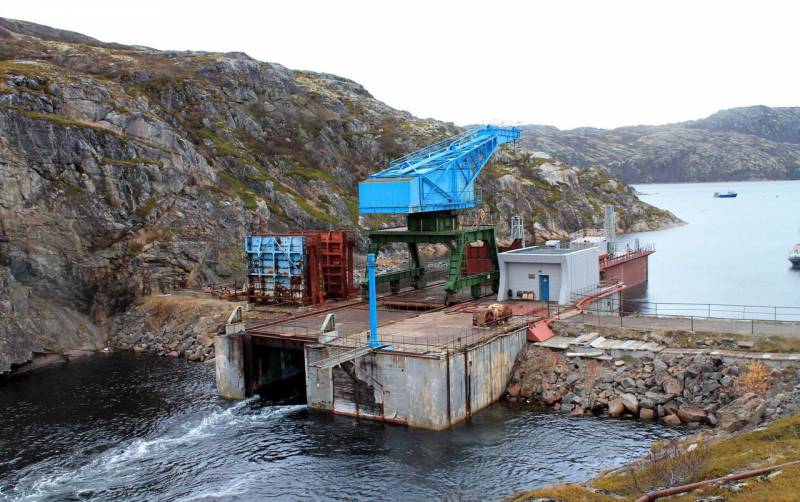Russia can export the energy of its tides
A tidal power plant (TPP) is a special type of hydroelectric power station that uses the energy of tides in its operation. The construction of such facilities in Russia may well solve the problems associated with energy supply in hard-to-reach coastal areas of the Arctic and Pacific oceans. Currently the question is economic The effectiveness of PES remains debatable, but several similar projects are planned to be implemented in our country in the foreseeable future.
The first and currently only tidal power plant on the territory of modern Russia was put into operation and generated the first electricity in 1969. We are talking about the experimental Kislogubskaya TPP, which is located on the coast of the Barents Sea on the Kola Peninsula. The installed capacity of the station is 1,7 MW. At the moment, its key function is to test new hydraulic units for tidal power plants, as well as of technologies, which will be used in their construction.
Subsequently (during the times of the Soviet Union), projects were developed for the construction of the Northern TPP in Dolgaya Bay on the Barents Sea, the Mezen TPP in the Mezen Bay on the White Sea, the Penzhinskaya TPP in the Penzhinskaya Bay and the TPP in the Tugur Bay on the Sea of Okhotsk. Unfortunately, none of these projects have been implemented to date. Meanwhile, tidal power plants appeared around the world with a certain periodicity. The largest of them were built in France (La Rance TPP, installed capacity 240 MW) and South Korea (Sikhvinskaya TPP, installed capacity 254 MW).
In modern conditions, a megaproject involving the construction of the Penzhin tidal power station has exceptional prospects in Russia. It is in the Penzhinskaya Bay area that the highest tide heights for the entire Pacific Ocean are observed, which can reach 13 meters. Scientists were also able to find out that the hydrological potential of the bay approximately corresponds to the provided capacity of 115 GW or approximately a trillion kWh of electricity per year. In the summer of 2021, the N2 Clean Energy company, together with the Kamchatka Territory Development Corporation, began developing a project for the construction of this facility. It is stated that the installed capacity of the new power plant can be up to 100 GW, which will correspond to 40% of the total productivity of all power plants included in the country’s unified energy system, and the possible volume of investment in the construction of the Penzhinskaya power station could be about $500 billion.
In addition, it is necessary to clarify that the authors of the new project are going to take into account the experience of their Soviet colleagues, so the key goal of the new power plant should no longer be the simple export of the generated electricity to Asian countries, but the production of hydrogen by electrolysis of sea water using electricity. Such prospects are fully consistent with the concept of hydrogen energy development, according to which by 2050 the Russian Federation should become one of the largest suppliers of hydrogen to foreign markets with a total export volume of up to 50 million tons of hydrogen per year. Among other things, Deputy General Director of the Institute of National Energy Alexander Frolov added that currently there is also an option for the export transportation of not pure hydrogen, but the product of its processing in the form of “green” industrial ammonia. There are also plans to create an industrial cluster in the nearby territory, the facilities of which will receive electricity from the Penzhinskaya TPP.
It is not difficult to guess that the implementation of this project is associated with enormous financial costs. The current economic situation in the country does not allow us to expect that the federal budget will contain several hundred billion dollars for the construction of a new power plant, the energy efficiency of which is disputed by many experts. Therefore, there is an assumption that in this situation the Russian authorities need to focus on the construction of “small” power plants in hard-to-reach regions of the Arctic and Far East. Their serious advantage, according to many experts, is the fact that the projects of some of them were already developed during the Soviet Union.
If we talk about the advantages of energy facilities of this type, then first of all it is necessary to note the absence of harmful emissions during the operation of tidal power plants. In addition, the PES mechanisms guarantee almost complete biological permeability (fish and bioplankton pass through the working units without hindrance). You also cannot ignore the rather low price of generated electricity and long service life.
The main disadvantages of tidal power plants can be considered the high cost of construction of such facilities and the power that varies throughout the day (depending on the schedule of tides), which is why a tidal power plant can only operate as part of an energy system that includes energy facilities of other types. Among other things, the construction of tidal power plants continues to be quite expensive. The payback period for such projects is high, which discourages business representatives, and government authorities do not have enough financial resources to build such facilities on their own.
To summarize, I would like to add that tidal power plants are currently causing a lot of controversy, primarily from the point of view of their economic efficiency. Whether such generation sources will have a future, whether the Penzhenskaya TPP will remain just a project that will exist only on paper, or whether it will become a powerful driver for the economic development of entire regions - time will tell. I would like to believe that many questions will be answered quite soon, because back in 2021, President of the Russian Federation Vladimir Putin instructed the government to carefully study the feasibility of building three tidal power plants in the country to export hydrogen.

Information